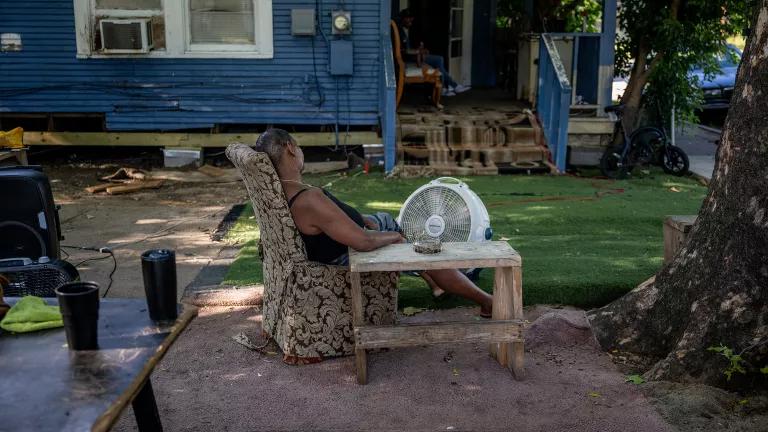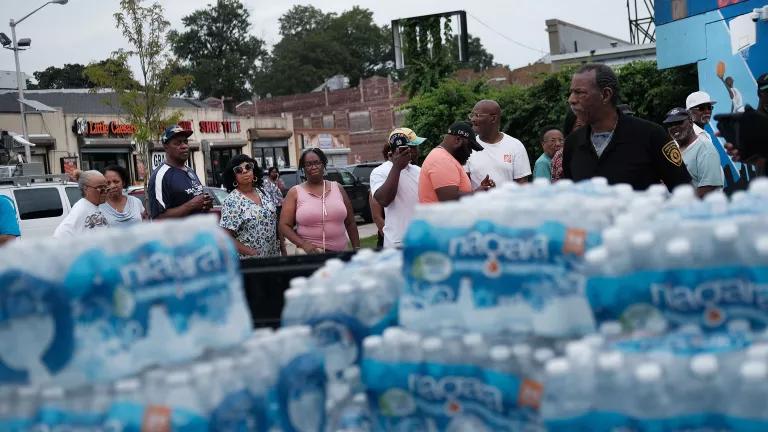Advancing Sanitation Equity in the 2023 Farm Bill
Increased and better-targeted USDA funding could help rural communities address sanitation challenges that threaten public health.

Catherine Coleman Flowers, second from the left, with a homeowner, second from right, and staff from government agencies looking at the homeowner’s straight pipe backyard sewage in Lowndes County, AL.
U.S. Department of Agriculture
This post was co-authored by NRDC’s Federal Water Policy Fellow for Summer 2023, Nicole Eastman.
Federal funding has substantial influence on rural communities’ ability to access effective drinking water and wastewater systems as well as protect public health. On July 19, 2023, the Senate Agriculture Committee’s Subcommittee on Rural Development & Energy held a hearing on rural wastewater and drinking water programs that could be addressed in the upcoming 2023 Farm Bill. This bill has the potential to authorize much-needed funding to low-income, rural communities experiencing septic system failures, drinking water contamination, and health risks due to improper sanitation. Experts from across the country attended the hearing to field questions from Senators and express their support and recommendations for the 2023 Farm Bill.
Rural Water and Sanitation Problems According to the Experts
Catherine Coleman Flowers, an NRDC board member and an influential leader in advocacy for access to wastewater infrastructure, shared her concerns as a first-hand witness to sanitation inequalities in places like her home, Lowndes County, Alabama. Flowers used her testimony to explain to the Senate Committee the evidence showing low-income and rural households are more likely to lack effective wastewater treatment.
Approximately 1 in 5 homes in the United States are not connected to centralized wastewater treatment systems, according to the Census Bureau’s American Housing Survey. This creates disproportionate burdens for low-income households who find themselves responsible for the cost of on-site treatment systems and their maintenance over the years. Rural communities often lack the financial capacity to handle these issues.
On-site sewer systems have an increased likelihood of failure, presenting substantial problems like sewage back-ups into homes and backyards. The impacts of climate change, such as heavy precipitation events and rising water levels, have increased these risks even further.
These sanitation failures threaten the health of people in communities across the country. A study conducted in 2017 revealed that many people in areas of Alabama experiencing sanitation failures had tested positive for hookworm, a gastrointestinal parasite. These damaging health effects also cause economic hardships for homeowners and businesses and take a toll on people’s mental health.
The impacts of failing sanitation systems are known to disproportionately impact rural areas. At the July 19 hearing, Jennifer Day, the director of development for RCAP Solutions, expressed concerns regarding the ability of large federal infrastructure programs to reach rural communities. Rural areas may be less likely to receive funding from federal programs such as the Clean Water and Drinking Water State Revolving Funds because they have a hard time competing against more populous urban areas. As a result, the rural development funding distributed through the Farm Bill is critically needed to help people living in these areas.
The Rural Decentralized Water Systems Grant Program
The USDA’s Rural Decentralized Water Systems grant program, which Catherine Coleman Flowers discussed at the hearing, provides an opportunity to address rural sanitation challenges. It assists nonprofits and tribes in establishing a revolving loan fund to improve access to clean, reliable water and septic systems for income-qualified households in eligible rural areas.
Senator Booker and Senator Capito, along with co-sponsors Rep. Sewell and Rep. Rogers in the House of Representatives, have introduced a bipartisan bill to extend and improve this program. NRDC and Flowers support the Booker-Capito legislation and are urging Congress to strengthen it further as they draft the upcoming Farm Bill.
In particular, the bill should be modified in the following ways to make progress toward achieving health and environmental justice.
- The bill currently maintains the program’s authorized funding level of $20 million per year. Congress should increase it to $25 million in Fiscal Year 2024 and $50 million in each year thereafter.
- The bill allows funds to be used to cover the cost of decentralized wastewater system warranties of at least 5 years, but these warranties would be optional. Congress should require all sanitation systems funded through this program to have a manufacturer's and an installer’s warranty for a minimum of 10 years to prevent potential financial burdens to homeowners.
- Grants and loans are currently available to households with an income below 60% of median household income (MHI), but the new bill increases the household income eligibility for loans to 100% of MHI. NRDC recommends increasing the income eligibility thresholds for grants in addition to loans, as families earning less than the median income may struggle to afford a loan.
- Finally, the bill raises the dollar limits on grants and loans from $15,000 to $20,000 each. However, areas with tight soils or high water tables cannot use conventional septic tanks, and more expensive on-site treatment systems are required at these sites. Congress should raise the dollar limit under this program to $35,000 for locations where soil and water conditions prevent the installation of conventional septic systems.

The installation of an on-site sewage treatment system.
Minnesota Pollution Control Agency
Funding Opportunities for Rural Water and Sanitation Programs through the Farm Bill
In addition to the Rural Decentralized Water Systems grant program, other USDA funding programs received a spotlight at the hearing. Another expert, Robert White IV, the executive director at Alabama Rural Water Association, stressed the importance of Farm Bill programs to fill the gaps left by funding from other primary sources, such as the American Rescue Plan Act (ARPA), State Revolving Funds, and the Bipartisan Infrastructure Law.
Existing USDA programs providing financial assistance for wastewater infrastructure, which should receive robust funding in this year’s Farm Bill, include:
- Water and Waste Disposal Loan and Grant Program
- This program is the largest USDA program funding wastewater and water infrastructure. The funds may be used for drinking water sourcing, treatment, storage, and distribution; sewer collection, transmission, treatment, and disposal; solid waste collection, disposal, and closure; and storm water collection, transmission, and disposal. Qualifying areas include rural areas and towns with populations of 10,000 people or less, tribal lands in rural areas, and colonias.
- Water and Waste Facility Loans and Grants to Alleviate Health Risks
- This program provides financial assistance for drinking water and waste disposal services to low-income communities. The funds may be used to build basic drinking water and waste disposal systems. Eligible areas include federally recognized Tribal lands and rural areas and towns with populations of 10,000 or less.
- Revolving Funds for Financing Water and Wastewater Projects
- This program assists nonprofits in establishing revolving funds for improvements to water and waste disposal systems in rural areas. The revolving loan fund can be used for pre-development costs for water and wastewater treatment projects and short-term small capital improvement projects that are not included in regular operations and maintenance. Rural areas and towns with populations of 10,000 or less, tribal lands in rural areas, and colonias qualify for this program.
- The Circuit Rider Program – Technical Assistance for Rural Water Systems
- This program aids with board training, management, finance, maintenance, compliance, reporting, disaster and emergency assistance, and loan applications through technical assistance. An eligible project area is an entity that must serve an area with a population of 10,000 people or less and be either a public body, non-profit organization, or tribe with legal authority to own the water facility.
In addition to current USDA funding opportunities, pending legislation, the Healthy H20 Act (H.R. 1721) would establish a new USDA grant program. This Act would create a grant program to assist with the purchase, installation, and maintenance of point-of-entry and point-of-use drinking water improvement products in rural and underserved communities.
These modifications to the Rural Decentralized Water System Grant Program as well as the reauthorization of the previously listed programs are essential in advancing sanitation efforts in rural and low-income communities across the United States. The Farm Bill presents a valuable opportunity to address health and environmental inequities, and as Catherine Coleman Flowers expressed “everyone has the right to sanitation.”




